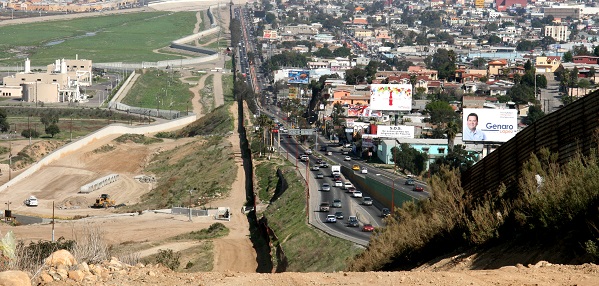Trump threatens tariffs; risks hurting Americans
April 9, 2019 | Expert Insights

Trump threatens to place a 25% tariff on cars coming to the US from Mexico, demanding Mexican action on illegal immigration and the drug trade.
Background
The Mexico–United States barrier, sometimes colloquially called the Border Wall, is a series of vertical barriers along the Mexico–United States border aimed at preventing illegal crossings from Mexico into the United States. The barrier is not one contiguous structure, but a discontinuous series of physical obstructions variously classified as "fences" or “walls.” The Mexico-US border is the most frequently crossed border in the world, running a total length of 3,145 kilometres. Such barriers are a typical physical manifestation of international boundaries to ensure economic, immigration and social distinction between multiple states.
Throughout his 2016 presidential campaign, Donald Trump called for the construction of a much larger and fortified border wall, claiming that if elected, he would "build the wall and make Mexico pay for it." Mexican President Enrique Peña Nieto has said his country would not pay for the wall. On January 25, 2017, the Trump administration signed Executive Order 13767, which formally directed the US government to begin attempting to construct a border wall using existing federal funding, although actual construction of a wall did not begin at this time due to the large expense and lack of clarity on how it would be paid for. The Trump administration has painted the situation on its southern border as a “crisis.”
Analysis
President Trump recently threatened to immediately close the border with Mexico, tweeting that Mexico must immediately stop “ALL illegal immigration coming into the United States.” Despite being a tall order for the Mexican state, Mr. Trump’s acting chief of staff Mick Mulvaney had reiterated the position, saying it would require something substantial for Mr. Trump not to shut down the border crossings.
However, in typical Trump style, the President abandoned the threat, instead of warning that the US would institute place tariffs on cars coming to the US from Mexico, unless a more concerted effort was displayed by the Mexicans, especially against illegal immigration and the drug trade. Mr. Trump characterised the move as a “less drastic measure” than the closing of the border. He added, “I don’t think we’ll ever have to close the border because the penalty of tariffs on cars coming into the United States from Mexico, at 25%, will be massive.”
The move comes as the Trump administration struggles to deal with what it believes to be a border crisis. This is especially pertinent given that Mr. Trump’s electoral base is fervently in support of a southern border wall, resulting in Mr. Trump making it one of the main components of his campaign pitches. The Trump administration has struggled to make good on a number of electoral promises, due to the Democrats’ capture of the House during the 2018 mid-term elections, which allows the opposition broad legal powers to check and balance the President’s moves.
The change in rhetoric is typical of Mr. Trump’s positions, who often uses overt threats to send parties into a panic in order to secure an end more conducive to that of the Trump administration. In this case, Mr. Trump must be perceived by his base as actively fighting the threat from the southern border. Seeing the likelihood of a friendly Congress diminish, Mr. Trump has turned his attention to the Mexican government, whom he can target much easier as the executor of American foreign policy, especially in terms of tariffs.
However, it is important for the Trump administration to remain cognizant of the recently concluded United States-Mexico-Canada Trade agreements which have not yet been ratified. Should this deal fracture, the Trump administration may face further economic hurdles in the near future. In addition, it is wise to remember that the while the manufacturers of products crossing the border pay tariffs, the cost is eventually borne by the final consumer, which, in this case, is the American people. The Trump administration has unwisely tied together two separate matters, i.e. illegal immigration (including its related problems) and tariffs, into one basket, which is not likely to have the intended effect. The President’s frustration with the inability to show progress on the Mexican issue is likely to lead the administration towards continued threats of excess in order to gain concessions, in typical Trump fashion.
Assessment
Our assessment is that the recent threat of tariffs on auto exports to Mexico is designed to affect change on the Mexican side of the US-Mexico border, in order to stem the flow of migrants into the US. We believe that Mr. Trump will likely continue to make such threats, and potentially carry them to fruition, goaded on by demands from his electoral base. We also believe that the institution of tariffs will eventually impact the American consumer the most.








Comments